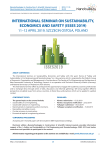Статьи журнала - Nanotechnologies in Construction: A Scientific Internet-Journal
Все статьи: 409
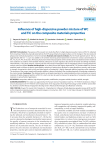
Influence of high-dispersive powder mixture of WC and TiC on the composite materials properties
Статья научная
Introduction. The purpose of the research is to study the effect of a high-dispersive powder mixture of WC, TiC, obtained from recycling of hard-alloy manufactured articles from TK group (titanium-tungsten alloys), on the change in the structural and physical and mechanical properties of cement materials. Materials and research methods. WC, TiC Powder (particle size 20–150 nm, agglomerates 300 nm – 1.5 μm) was added to the cement mortar by partial replacement of cement in various concentrations of 0%, 1%, 2%, 3%, 4%, 5% by mass. The basic physical and mechanical properties of the cement paste and obtained cement materials were studied in accordance with standard methods, taking into account regulatory documents of Russian and foreign standards. Thermokinetic, X-ray phase analysis, scanning electron microscope investigation with an integrated system of energy-dispersive analysis were also applied. Results and discussion. It has been proved that highly dispersed WC, TiC powder additive to cement materials leads to increase in density, paste fluidity, reduction in setting time, decrease in water absorption, porosity, and increase in strength characteristics both in early and later periods of hardening. A highly dispersed additive promotes earlier hydration. The structure of the cement sample with powder additive is denser throughout the considered periods of hardening compared to the control sample. Conclusion. The obtained results are of great importance for understanding the action mechanism on cement materials of highly-dispersed particles of WC, TiC, which can later be used to improve the properties of composite cement-based materials in various fields of application.
Бесплатно
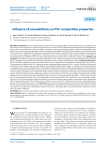
Influence of nanoadditives on PVC composition properties
Статья научная
Introduction. In this scientific article a scheme of the no synergistic effect is observedion process is considered. It has been shown that to slow down or suppress the main process occurring in the condensed phase and determining the formation of gaseous fuel several methods can be used: addition of polymers with increased thermal stability; addition of nanoadditives that reduce the amount of gaseous degradation products; introducing nanoadditives that affect the heat capacity or thermal conductivity of the system, thus changing the thermophysical characteristics of the polymer material. At the same time reduced reaction speeds, occurring in the gas phase and supporting the combustion process, can be achieved through reduction of the concentration of combustible gases and inhibition of the reactions responsible for the branching of the combustion chain process. Methods and materials. The composition and physical properties of kaolin are given. Kaolin monocrystal is a two-layer aluminosilicate containing water of hydration and consisting of chemically bonded layers of silicon dioxide and hydrated alumina. Results and discussion. We have studied the dependence of the attenuation time of a PVC composition on a composition containing from 3 to 10% kaolin. The introduction of kaolin into the PVC compound has led to decrease of decay time from 4.5 to 1 seconds. The effect of the amount of plasticizer on the oxygen index has been studied. We used dibutoxyethyl adipate (DBEA) as a plasticizer. It has good polymer compatibility and is environmentally friendly. The possibility of reducing the content of dibutoxyethyl adipate in the basic formulation of the original plasticate I40-13A by increasing the amount of calcium carbonate was studied, then the performance properties of the resulting compositions were studied. The content of PVC and other components in the basic recipe remained unchanged. Analysis of the data showed that for plasticization of 62% wt PVC contained in I40-13A, 20% wt DBEA is sufficient, while the filler content can be increased at least twice. The oxygen index (OI) value at a component ratio of 20% DBEA + 13.56% CaCO3 increases by 4 OI units and becomes equal to 29.1%. The dependence of the oxygen index of PVC compound on the composition containing from 5 to 20% kaolin has been studied. The results showed that the oxygen index of plastic compound increases significantly with increasing kaolin content. The OI drops with a decrease in the amount of the introduced, and it remains unchanged with its increase. Thus, the optimal content is 15%. Conclusion. Thus, kaolin is a promising, inexpensive and environmentally friendly filler for PVC materials, which effectively reduces their combustibility. The same effect is achieved by increasing the content of calcium carbonate in the original PVC compound formulation. However, no synergistic effect was observed while mixing kaolin and an excess of calcium carbonate.
Бесплатно
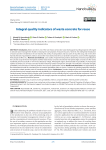
Integral quality indicators of waste concrete for reuse
Статья научная
Introduction. Waste concrete is one of the main heavy construction waste having good recycling prospects with regard to rational nature management related to reducing the consumption of natural resources. However, the widespread introduction of waste concrete is hindered on the one hand by the variety of compositions and structures of recycled scrap, and on the other hand by the lack of quantitative criteria to choose the most rational area of its use (a binder component, coarse and fine aggregate, finely dispersed filler, etc.). Materials and methods. Case studies of experimental powders obtained by mechanical grinding from the concrete scrap of internal wall panels and floor slabs (heavy concrete) and external wall panels (light concrete) of a five-storey residential panel house built in 1979 in the Obozersky village, Arkhangelsk region, demonstrated the possibility of choosing the optimal secondary use of waste concrete fractions featuring residual compressive strength. The indicators of residual strength, grindability and contraction of mineral powders were used as optimization criteria. Results and discussions. The applicability of the mathematical model for calculating the raw material grindability index is shown. A criterion for grinding equipment selection is proposed to obtain powders with an extended active surface. Conclusions. Powders obtained from the fraction of waste light concrete featuring low strength properties and grindability by mechanical grinding to a specific surface area comparable to that of Portland cement used and having a higher value of contraction can be rationally used as a composite binder component. Concrete scrap fractions featuring by higher grindability and strength properties are optimally suited for crushed aggregate preparation in the concrete composite production process.
Бесплатно
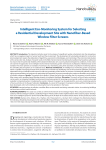
Статья научная
Introduction. The industrial activities result in the release of a significant number of pollutants into the atmosphere, which have a negative impact on human health and the environment. The development of sustainable principles for construction sites development requires the elaboration of algorithms, assessment methodologies, and monitoring of the environmental situation at the construction site. Analysis of research works in the field of environmental monitoring of air pollution by hazardous substances has shown that the speed and reliability of the obtained information are crucial in polluted atmospheric conditions. In this article, we examine the application of an intelligent environmental monitoring system with Salavat city Republic of Bashkortostan as the example. The article presents an example of continuous eco-monitoring using three automatic air pollution monitoring stations for controlling the atmospheric air in residential areas. Methods and Materials. An intelligent eco-monitoring system is proposed, which is capable of assessing the state of the air basin of an industrial city, identifying sources of increased air pollution, processing information using an artificial neural network in real-time, generating control actions on sources of increased air pollution, and providing recommendations to businesses for optimizing their operations to prevent exceeding the maximum allowable concentrations of harmful substances. Results. The analysis of air quality in Salavat has led to the conclusion that it is necessary to install window filter-screens with nanofiber-based filtering elements in residential buildings. Discussion. The results of the air basin monitoring can be used in an integrated intelligent environmental monitoring system for assessing environmental conditions and can be made available to interested parties. Considering the results in Salavat, the project can be replicated for use in eco-monitoring systems of towns and cities in the Russian Federation. Conclusion. As a result of the project, the program utilizing artificial intelligence has been developed, which will contribute to reducing the level of air pollution in the future.
Бесплатно
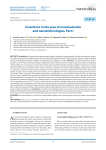
Inventions in the area of nanomaterials and nanotechnologies. Part I
Статья научная
Introduction. Advanced technologies impress people’s imagination demonstrating the latest achievements (materials, methods, systems, technologies, devices etc.) that dramatically change the world. This, first of all, concerns nanotechnological inventions designed by scientists, engineers and specialists from different countries. Main part. The article provides an abstract overview of inventions of scientists, engineers and specialists from different countries: Germany, Iraq, China, Russia, USA, Ukraine, Sweden, Japan et al. The results of the creative activity of scientists, engineers and specialists, including inventions in the field of nanotechnology and nanomaterials allow, when introduced to industry, achieving a significant effect in construction, housing and communal services, and related sectors of the economy. For example, the invention «Nanomodified building mortar» refers to construction materials and can be used in masonry of ceramic stones, ceramic bricks, hollow bricks in dry and hot climate. The novelty, in respect to the existing construction mortars, is the combination of known components of Portland cement, sand for construction works, amorphous nanomodified silica dioxide, superplasticizer С-3, cure retarders of Portland cement, air-entraining resin. The given qualitative and quantitative composition of nanomodified construction mortar makes it possible to obtain the mentioned mixtures in a simple way: for example, in gravity mixer, with evenly distributed components in volume, which is characterized with specified flowability, water-retaining property, controlled hardening period and can be used in dry and hot climate with air temperature up to 40-50°С. The following inventions in the field of nanotechnology can also be interesting for specialists: a composition of self-compacting construction concrete on the basis of cement matrix, a method of producing polarization-sensitive nanocomposite film on the basis of copper selenide, a method of producing porous moulded article in the form of insulation plaster layer, a method to obtain amorphous nanostructured diamond-like coating, a method of cement surface modification, a system to produce carbon nanotubes, et al. Conclusion. One of the most challenging tasks the economy of every country faces is to increase industrial competitiveness through technological upgrade. From the side of the state and companies the principal object to control in this process are the people and enterprises dealing with introduction of inventions and new technologies.
Бесплатно
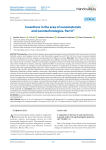
Inventions in the area of nanomaterials and nanotechnologies. Part II
Статья научная
Introduction. Advanced technologies impress people’s imagination demonstrating the latest achievements (materials, methods, systems, technologies, devices etc.) that dramatically change the world. This, first of all, concerns nanotechnological inventions designed by scientists, engineers and specialists from different countries. Main part. The article provides an abstract overview of inventions of scientists, engineers and specialists from different countries: Germany, Russia, USA, et al. The results of the creative activity of scientists, engineers and specialists, including inventions in the field of nanotechnology and nanomaterials allow, when introduced to industry, achieving a significant effect in construction, housing and communal services, and related sectors of the economy. For example, the task resolved by the invention «A composition on the basis of oxide nanostructures to provide surface with superhydrophobic properties», means to design a new method of obtaining materials with superhydrophobic properties which possess improved performance and functional characteristics which can be applied in various areas: power engineering, electronics, machine-building, construction, ship-building, aviation, aerospace and food industries. The feature of the invention is that the surfaces demonstrate superhydrophobic properties and, as a result of that, their applying allows protecting metal structures, such as power lines, frame structures, roofs, from ice formation and dirtying. The technical result is possible due to the use of composition on the basis of oxide nanostructures to provide surface with superhydrophobic properties. The composition contains tetraethoxysilane and tetraisopropyl titanate as structure-forming agents, hexamethyldisilazane as hydrophobic element, isopropyl alcohol as dissolvent, non-spheric nanocrystal titanium dioxide with particle size from 10 to 50 nm as a grow accelerator of anisotropic structures to provide specified roughness of the surface. The specialist can be also interested in the following inventions in the area of nanotechnologies: a composite heat-conducting material on the basis of nanoliquid, a nanocomposite material on the basis of potassium titanate, a method of obtaining of nanodispersed powders, hybrid supercondenser on the basis of nanosized nickel hydroxide, etc. Conclusion. One of the most challenging tasks the economy of every country faces is to increase industrial competitiveness through technological upgrade. From the side of the state and companies the principal object to control in this process are the people and enterprises dealing with introduction of inventions and new technologies.
Бесплатно
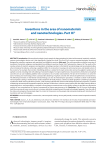
Inventions in the area of nanomaterials and nanotechnologies. Part III
Статья научная
Introduction. Advanced technologies inspire people by demonstrating the latest achievements (materials, methods, systems, technologies, devices etc.) that dramatically change the world. This, first of all, concerns nanotechnological inventions designed by scientists, engineers and specialists from different countries. Main part. The article provides an abstract overview of inventions of scientists, engineers and specialists from different countries: Russia, USA, Turkmenistan, Japan et al. The results of the creative activity of scientists, engineers and specialists, including inventions in the field of nanotechnology and nanomaterials allow, when introduced to industry, achieving a significant effect in construction, housing and communal services, and related sectors of the economy. For example, the invention «Modifying additive» is related to the road construction and can be applied in production of asphalt-concrete, including that with utilizing of nanotechnologies. To improve performance characteristics of bitumen and asphalt concrete one can use modifying additive which comprises a mix of carbon nanomaterials. The aim of the invention is to solve the task of creating new technology which could provide obtaining of asphalt concrete with enhanced performance characteristics. The following inventions in the field of nanotechnology can also be interesting for specialists: a method to obtain multi-layered nanocomposite coating; a method of laser surface treatment for steel products; a device to obtain graphene-containing suspension; a method to obtain nanocrystal silicon powder; a self-cleaning material with chemical and biological protection properties; a method of obtaining nanostructured composite material on the basis of aluminum; a device control system with the shape memory effect to manipulate micro- and nanoobjects; a method to form plasmon nanostructures on the object surfaces to provide non-destructive analysis of low concentrations of chemical compounds by Raman spectroscopy et al. Conclusion. One of the most challenging tasks the economy of every country face is to increase industrial competitiveness through technological upgrade. From the side of the state and companies the principal object to control in this process are the people and enterprises dealing with introduction of inventions and new technologies.
Бесплатно
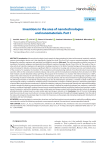
Inventions in the area of nanotechnologies and nanomaterials. Part I
Статья научная
Introduction. Advanced technologies inspire people by demonstrating the latest achievements (materials, methods, systems, technologies, devices etc.) that dramatically change the world. This, first of all, concerns nanotechnological inventions designed by scientists, engineers and specialists from different countries. Main part. The article provides an abstract overview of inventions of scientists, engineers and specialists from different countries: Germany, Russia, China, USA et al. The results of the creative activity of scientists, engineers and specialists, including inventions in the field of nanotechnology and nanomaterials allow, when introduced to industry, achieving a significant effect in construction, housing and communal services, and related sectors of the economy. For example, the invention «The composition and manufacturing method of non-fired zirconium heat-resistant concrete» refers to the construction materials industry and can be used in the manufacture of products from zirconium non-fired heat-resistant concrete obtained without pre-firing. The purpose of the invention is to increase the thermal resistance at 1300оC, improve the water resistance of non-fired zirconium heat-resistant concrete and the exclusion a technologically complex method of converting the above-mentioned components into nanoscale particles and heat-shock treatment requiring high energy costs. The following inventions in the field of nanotechnology can also be interesting for specialists: a method to obtain multi-layered nanocomposite coating: a method for modifying carbon nanomaterials in nitrogen-containing plasma; a method for regeneration of aerosol filters and protective membranes; a method for obtaining a polymer nanocomposite material with reduced flammability; a robotic complex for obtaining nanostructured chromium coatings; a method for producing hydrogen from methane, a method for forming a combined hydrophilic coating; thermochromic nanoencapsulated material, production method and a product containing such material; a method for obtaining a water-soluble paint-and-lacquer material with photobactericidal activity for applying photobactericidal coatings based on water-soluble paint-and-lacquer materials еt al. Conclusion. One of the most challenging tasks the economy of every country face is to increase industrial competitiveness through technological upgrade. From the side of the state and companies the principal object to control in this process are the people and enterprises dealing with introduction of inventions and new technologies.
Бесплатно
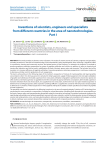
Статья научная
The article provides an abstract review of patents. The results of creative activity of scientists, engineers and specialists, including inventions in the field of nanotechnology and nanomaterials, being implemented, allow achieving a significant effect in construction, housing and community services, and related sectors of the economy. For example, the invention «A method to produce graphene-containing suspensions by means of graphite exfoliation and a device to perform it» refers to chemical and construction industries and can be used in modification of plastic lubricant, epoxy resins and concretes. The technical task of the invention is to increase efficiency of graphite exfoliation, to produce graphene-containing suspensions in continuous mode and to decrease unit labor costs for production of such suspensions. The task is achieved due to the following steps of the method: preparation of mixture of crystal graphite and liquid, graphite concentration is from 10 to 20 mass percent in container for initial suspension, supply of initial suspension into rotor plant, exfoliation of graphite and withdrawal of treated suspension from rotor plant, exfoliation of graphite is performed in several rotor plants one after another, and initial suspension is supplied into the first rotor plant by pump with fixed consumption, after treated suspension has been withdrawn from one of rotor plant, it is supplied into next rotor plant, and from the last rotor plant treated suspension is delivered into centrifugal separator, after separation centrifuge effluent is supplied into container of finish product and precipitate is delivered to a container of initial suspension in which graphite and liquid are added to obtain specified concentration of graphite in initial suspension. The specialists can also be interested in the following inventions in the area of nanotechnologies: Evolution of PV technology from conventional to nano-materials; a composition of coating for colored decoration of building walls; ferroelectric nanocomposite on the basis of porous glass and monopotassium phosphate materials; innovative technology of municipal wastewater treatment for rapid sludge sedimentation and enhancing pollutants removal with nano-material, a method to obtain powder mixture of bidispersed ceramic and metal particles, micro- and nano-plastic pollution: behavior, microbial ecology, and remediation technologies; a method to obtain multilayer wear-resistant diamond like coatings; fuel element with composite protective coating et al.
Бесплатно

Статья научная
The article provides an abstract review of patents. The results of creative activity of scientists, engineers and specialists, including inventions in the field of nanotechnology and nanomaterials, being implemented, allow achieving a significant effect in construction, housing and community services, and related sectors of the economy. For example, the invention «Method for liquidphase synthesis of nanostructured ceramic material in the CeO2–Sm2O3 system to create a solid oxide fuel cell» can contribute to the active development of alternative, hydrogen energy. Fuel cells have a wide range of applications – from batteries in portable electronic devices to large-scale power generation and autonomous use (for example, in remote areas). Power plants based on fuel cells are almost twice as economical as traditional ones. Their efficiency can reach 85%, and the amount of harmful emissions is almost 100 times lower due to the lack of direct chemical contact of the fuel with the oxidizer. The specialists can also be interested in the following inventions in the area of nanotechnologies: method of increasing the tensile strength of fiber composites by means of preliminary modification of carbon fibers with carbon nanotubes and molecules containing amino groups; preparation method of pure silver nanowires; towards safe and sustainable innovation in nanotechnology; method of distribution of carbon-based nanoparticles in the production of nanocomposite unidirectional thermoplastic tapes; device for reducing the impact of vibration and shock effects on the performance of technological equipment; high-density three-dimensional electrically conductive micro- and mesoporous material based on carbon nanotubes and / or low-layer graphenes and a method for its preparation; nanotechnology as a viable alternative for the removal of antimicrobial resistance determinants from discharged municipal effluents and associated watersheds; and others.
Бесплатно

Статья научная
Introduction. Advanced technologies impress people’s imagination demonstrating the latest achievements (materials, methods, systems, technologies, devices etc.) that dramatically change the world. This, first of all, concerns nanotechnological inventions designed by scientists, engineers and specialists from different countries. Main part. The article provides an abstract review of patents. The results of creative activity of scientists, engineers and specialists, including inventions in the field of nanotechnology and nanomaterials, being implemented, allow achieving a significant effect in construction, housing and community services, and related sectors of the economy. For example, the invention «Composite material with oriented carbon nanotubes» refers to the area of composite materials which consist of polymer matrix and filler that is often presented by carbon nanotubes. The technical result is increased tensile strength of composite material due to formation of structure of oriented carbon nanotubes in polymer matrix. That is performed by means of flat-rate flow of direct current which destroys filler agglomerates. The specialists can also be interested in the following inventions in the area of nanotechnologies: a method to produce powder containing nanocrystalline cubic tungsten carbide; a method to produce porous graphene membranes and the membranes produced with this method; suppressor coating on the basis of polymer matrix with inclusion of carbon nanotubes and a method to produce it; a method to determine location of polyethylene gas pipeline and places of possible illegal tapping of those pipeline; a method to produce biphasic thermoelectric ceramics; electron-beam system of 3D radiant nanomodification for materials and articles; lab-on-fruit skin and lab-on-leaf towards recognition of trifluralin using Ag-citrate/GQDs nanocomposite stabilized on the flexible substrate: A new platform for the electroanalysis of herbicides using direct writing of nano-inks and pen-on paper technology; and others. Conclusion. One of the most challenging tasks the economy of every country face is to increase industrial competitiveness through technological upgrade. From the side of the state and companies the principal object to control in this process are the people and enterprises dealing with introduction of inventions and new technologies.
Бесплатно

Статья научная
Introduction. Advanced technologies impress people’s imagination demonstrating the latest achievements (materials, methods, systems, technologies, devices etc.) that dramatically change the world. This, first of all, concerns nanotechnological inventions designed by scientists, engineers and specialists from different countries. Main part. The paper briefly reviews inventions made by scientists, engineers and specialists from different countries: Russia, USA, China, Belarus, Great Britain, Vietnam, Denmark, the Kyrgyz Republic. The application of the results of scientists’, engineers’ and specialists’ investigations, including inventions in the area of nanotechnology and nanomaterials allow achieving significant efficiency in construction, house and communal service, related sectors of economy. For example, the invention “A method to modify concrete with complex additive which includes hydrothermal nanoparticles SiO2 and multi-layer carbon nanotubes” refers to methods of modifying concrete by introducing combination of nanoparticles with high specific surface into concrete mixture and can be used in production of precast and monolithic parts and structures of buildings and facilities of different purpose. This method of nanomodifying concrete makes it possible to achieve increased mechanical characteristics of concrete: compressive strength (25–77% at the age of 28 days) and bending strength, resistance to damage, Young’s mod of elasticity and shearing modulus, density (up to 10%), accelerated hardening at the early age and rate of strength development, decreased water absorbtion ability and improved indicators of porous structure (pore size and pore differential size uniformity), decreased total capillary porosity, increased frost resistance. The specialists can also be interested in the following nanotechnological inventions: a method to obtain polycrystalline diamond films; phase change materials for building construction: an overview of nano-/microencapsulation, solar collector of transpiration type; a method to obtain composition for antimicrobic coating on the basis of silver sulphide associates with molecules of methylene blue; broadband electromagnetic absorbing coating; a method to produce dry building mixtures; self-organizing nanostructures and separation membrane including aquaporin water channels and the methods to produce and use them; a method to obtain nanocrystalline titanium dioxide with anatase structure, etc. Conclusion. One of the most challenging tasks the economy of every country face is to increase industrial competitiveness through technological upgrade. From the side of the state and companies the principal object to control in this process are the people and enterprises dealing with introduction of inventions and new technologies.
Бесплатно

Статья научная
Introduction. Advanced technologies impress people’s imagination demonstrating the latest achievements (materials, methods, systems, technologies, devices etc.) that dramatically change the world. This, first of all, concerns nanotechnological inventions designed by scientists, engineers and specialists from different countries. Main part. The article provides an abstract overview of inventions of scientists, engineers and specialists from different countries: Russia, USA, China, Belarus, Italy. The results of the creative activity of scientists, engineers and specialists, including inventions in the field of nanotechnology and nanomaterials allow, when introduced to industry, achieving a significant effect in construction, housing and communal services, and related sectors of the economy. For example, the invention «Protective coating and method of its application» relates to the field of protecting metals from corrosion. To obtain a protective coating, a composition containing an industrial oil with a powder of a phosphorusmodified copper-carbon nanocomposite is applied to the surface of an unalloyed steel and subjected to thermochemical activation by heating for 20 minutes at a temperature of 100–200°C. During the formation of the coating, strong donor-acceptor bonds of iron atoms with phosphorus, which are in the composition of the copper-carbon nanocomposite, are formed. In the course of experiments, it was found that heating samples with a coating of oil with the addition of a phosphorus-modified copper-carbon nanocomposite to 100–200°C increases the chemical activity of the nanocomposite, as a result of which a protective coating forms on the surface, which reduces the corrosion rate depending on the concentration of the modified metal-carbon nanocomposite. by 70–95%. The following inventions in the field of nanotechnology are also of interest to specialists: a method for obtaining a nanostructured surface of a metal workpiece by laser treatment, a device for producing nanodispersed metal oxides, a method for producing a nanostructured composite material based on aluminum, a method for modifying the surfaces of plates of a brazed plate heat exchanger, etc. Conclusion. One of the most challenging tasks the economy of every country face is to increase industrial competitiveness through technological upgrade. From the side of the state and companies the principal object to control in this process are the people and enterprises dealing with introduction of inventions and new technologies.
Бесплатно

Статья научная
Introduction. Advanced technologies impress people’s imagination demonstrating the latest achievements (materials, methods, systems, technologies, devices etc.) that dramatically change the world. This, first of all, concerns nanotechnological inventions designed by scientists, engineers and specialists from different countries. Main part. The article provides an abstract overview of inventions of scientists, engineers and specialists from different countries: Russia, USA, China, Kazakhstan, Sweden. The results of the creative activity of scientists, engineers and specialists, including inventions in the field of nanotechnology and nanomaterials allow, when introduced to industry, achieving a significant effect in construction, housing and communal services, and related sectors of the economy. For example, the invention «A method to obtain polymer-composite material and a composite reinforcement» relates to construction materials and is designed to reinforce building structures, that allows obtaining strengthened stressed composite reinforcement with improved physical-mechanical characteristics, increased resistance to aggressive environments. A method to obtain polymer-composite material is a multi-stage production of colloid solution on the basis of epoxy resin with addition of carbon nanotubes and applying heat and ultrasound impact. Introduction of modifiers (fillers) in polymer matrix in a certain ratio and fillers orientation make it possible to create a polymer strengthened for mechanical loads and with increased resistance to aggressive media (acid-resistance and alkali-resistance). The following inventions in the field of nanotechnology can also be interesting for specialists: a method to obtain biocide suspension applied on wallpaper and wall finishings, a method of aerosol spraying of nanoparticles in constant electric field, a method to obtain amorphous nanostructured diamond-like coating, a polymer composite heat-conducting paste with nanofiber modifier, a plant to provide controlled electroimpulse obtaining of nanoparticles of current conducting materials, etc. Conclusion. One of the most challenging tasks the economy of every country faces is to increase industrial competitiveness through technological upgrade. From the side of the state and companies the principal object to control in this process are the people and enterprises dealing with introduction of inventions and new technologies
Бесплатно
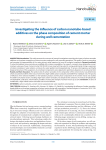
Статья научная
Introduction. This article presents the outcomes of research investigations examining the impact of carbon nanotube additives on the phase composition of cement mortars employed in well cementing operations. The quality of work on cementing and ensuring the impermeability of the casing string is quite important in terms of ecological compliance. Research methods. To solve this problem, heavy concrete was modified with a carbon nanoadditive. For research, a cement stone obtained by normalmoisture curing was chosen. Cement mortar CEM III/A32.5H was mixed with tap water for curing, preliminarily stirring a suspension of carbon nanotubes in water solution, a mixture of a water repellent and a hyperplasticizer. To ensure a homogeneous and highly dispersed structure of this suspension, its constituent components were subjected to preliminary dispersion in an ultrasonic field. Results and their discussion. The optimal ratio of carbon nanotubes in the composition of the cement mortar was determined, which amounted to 0.005% of the mass of cement for single-walled carbon nanotubes and 0.0005% for multilayer ones. The process of influence of the selected modifiers on the hydration products and the phase composition of the cement mortar was studied. An additive of complex action, including single-layer carbon nanotubes, was dispersed into solutions of a mixture of hydrophobic and hydrophilic surfactants, which made it possible to increase the strength of cement mortars up to 55%. Conclusion. In terms of modification, single-walled carbon nanotubes are the most efficient.
Бесплатно
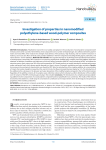
Investigation of properties in nanomodified polyethylene-based wood-polymer composites
Статья научная
Introduction. Polyethylene is by far the most widely used polymer in the production of wood-polymer composites both in Russia and in other countries. Nevertheless, these composites have a number of disadvantages: low adhesion between polymer matrix and wood filler, which reduces the strength characteristics of the products, high elasticity, and low weather resistance. In industry, such issues are often solved by using complex additives in the form of granules including binding agents, lubricants, and various thermo- and UV-stabilizers. Methods and materials. New experimental data on technological and operational characteristics of wood-polymer composites (WPC) based on low-pressure polyethylene modified with complex processing additive have been obtained. In addition to stabilizers and lubricants, multi-wall carbon nanotubes (MWCNT) were introduced in WPC to facilitate the extrusion process, their content was 30% of the total composition. WPC-based products are mainly intended for outdoor performance under mechanical load, which places special demands on them in terms of strength, weathering and water resistance. Results. An increase in the mechanical characteristics was found for WPC after the introduction of the complex additive: at a concentration of 2.6 phr, the tensile strength increased by 35%, and at 53.3 phr, the flexural strength became higher by 12%. The introduction of the additive led to a decrease in the abrasion and water absorption of the modified sample compared to that of the initial material. Regardless of the additive content, all the samples were uniformly colored, which indicated a uniform distribution of the modifier over the volume of the WPC melt during processing in the extruder. Conclusion. The introduction of a complex processing stabilizing additive into the composition of a wood-polymer composite based on polyethylene was carried out. The results of the research showed that the additive in a wide range of concentrations contributes to the improvement of the technological and operational properties of the resulting composites.
Бесплатно
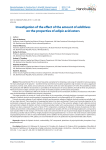
Investigation of the effect of the amount of additives on the properties of adipic acid esters
Статья научная
Polyvinylchloride (PVC) is the most frequently used polymer for obtaining a wide range of materials for various purposes. The main advantages of the polymer – excellent thermal and electrical insulation properties, high resistance to various aggressive substances, namely: acids, alkalis, various lubricants; lack of taste, smell; low water absorption (0.4–0.6%). The possibility to obtain PVC-plasticates with different characteristics is provided by the introduction of various additives, the bulk of which are plasticizers. Plasticizers based on adipic acid esters give a number of valuable properties to PVC-based compositions. However, the use of plasticizers affects the resistance of compounds to the combustion, therefore, the substances which eliminate this disadvantage are added in the polymer composition. This paper presents the results of a study of the effect of the composition of mixed plasticizers (symmetric and asymmetric adipates of aliphatic alcohols and phosphate of oxypropylated phenol) on the flammability of PVC composition. Primarily symmetric adipate of cyclic aliphatic alcohols and asymmetric adipate of aliphatic alcohols containing cycloalkyl radical have been derived. Then phosphate of oxypropylated phenol has been synthesized. Physical and chemical properties of the synthesized compounds were studied. Mixtures of plasticizers on the basis of the symmetric adipate of cyclic aliphatic alcohols and asymmetric adipate of aliphatic alcohols containing cycloalkyl radical with varying amounts of phosphate of oxypropylated phenol have been composed. The results of tests of PVC compositions containing the obtained mixtures of plasticizers for flammability are presented. Combustibility parameters of cable plasticate samples with the use of developed plasticizers correspond to state standard 5960-72 with changes 3-9. The best results were achieved with the use of asymmetrical adipate of aliphatic alcohols containing cycloalkyl radical and 4% by weight phosphate of oxypropylated phenol. It is shown that small amounts of phosphate oxypropylated phenol are able to reduce flammability, further addition of this plasticizer leads to a deterioration in performance. The developed formulations of PVC plastics are recommended for use in the production of polyvinylchloride cable sheaths.
Бесплатно
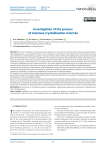
Investigation of the process of moisture crystallization in bricks
Статья научная
To solve the problems concerning moisture behaviour in the material of construction’s enclosure, especially at alternating temperatures, is very important for the correct calculations of resistance to heat conduction of construction’s enclosure and, ultimately, for comfortable living conditions. However, there are still no methods for building enclosure’s materials that could determine the temperature of moisture crystallization in the material in solid phase. The premise of the research is that water incoming to the material of construction’s enclosure, presenting in the construction’s material in the form of oxides and salts, as a result of hydrolysis process of some elements, is an eutectic solution with unstable composition and concentration. Thus, the research of moisture crystallization process transfers from micro- area (when determining the temperature of crystallization by the size of material’s pores) to the nano- area when researching the eutectic solution at the possible condition of hydrates formation. The experimental technique was developed to perform laboratory research of the process of moisture freezing. The technique takes into account that freeze-thaw process of moisture in solid body is studied at significant difference between mass of liquid phase and mass of solid phase. The method was simplified for the broad use at working conditions. The simplicity of the method aimed at obtaining experimental resultsis compensated by the developed mathematical method of processing the results of the research. Mathematical solution of the problem based on the comparison of freezing curves behaviour of the samples in dry and humidified samples. Apart from the temperature of moisture freezing, the developed method allowed obtaining additional characteristics of moisture states, such as amount of unfrozen moisture in construction’s material, supercooling temperature, heat capacity of moisture in liquid and solid states, concentration of dissolved agents. Knowing the concentration of dissolved agents in the material, even without knowing the exact composition of these agents, allows manipulating the temperature of moisture freezing at the nanotechnology level.
Бесплатно

